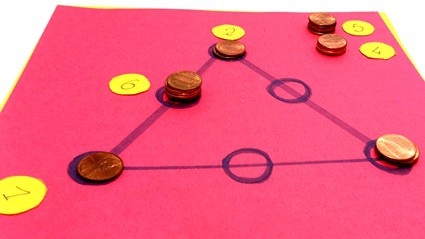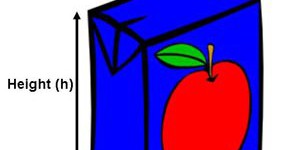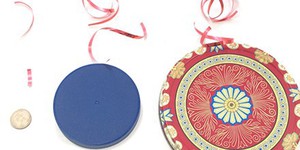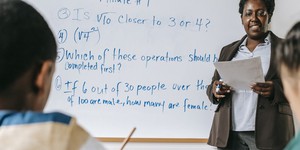Summary
Introduction
Do you ever use math as a tool to solve interesting problems? In the 1970s math was often taught with simple worksheets. One teacher developed an exciting way to learn math and logic; he developed what is now known as the perimeter magic triangle puzzles. Try them out—and have some fun as you start thinking about counting in a whole new way!
Materials
- Magic triangle template or materials to make one yourself:
- Two sheets of 9 by 12-inch paper, such as construction or craft paper (if possible, choose contrasting colors)
- Pencil or marker
- Ruler
- A quarter or other round object of similar size
- Scissors
- 21 pennies, small blocks or other small stackable objects
- Option: More sheets of paper
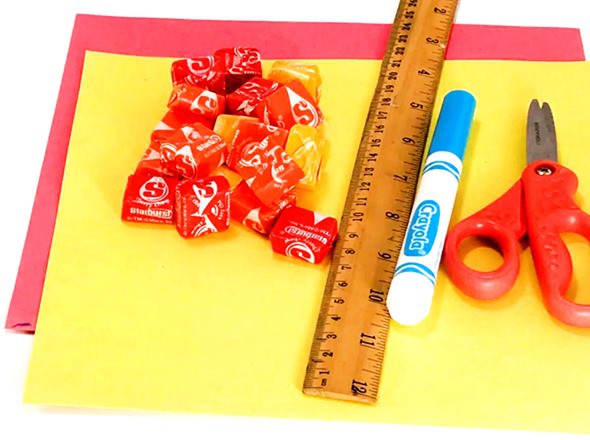 Image Credit: Sabine De Brabandere, Science Buddies / Science Buddies
Image Credit: Sabine De Brabandere, Science Buddies / Science Buddies
Prep Work
- If you use the magic triangle template, cut along the dashed lines and move on to step 4.
- To create the triangle:
- Draw a large triangle on a sheet of paper (you can use a ruler to help make straight lines).
- Use a quarter to trace a circle on each corner of the triangle and in the middle of each side. You should have six circles.
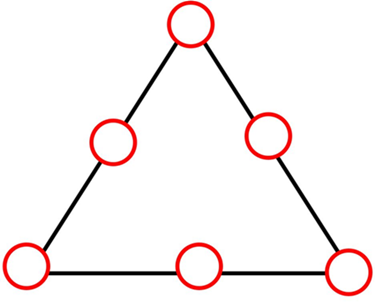 Image Credit: Sabine De Brabandere, Science Buddies / Science Buddies
Image Credit: Sabine De Brabandere, Science Buddies / Science Buddies
- To create the number disks:
- Draw six circles similar in size to the ones drawn on the triangle. Use a sheet of paper with a contrasting color if possible.
- Cut out these circles, and number them 1 through 6.
- Choose 21 small objects that stack easily. Pennies, math cubes and stackable candy are all good choices.
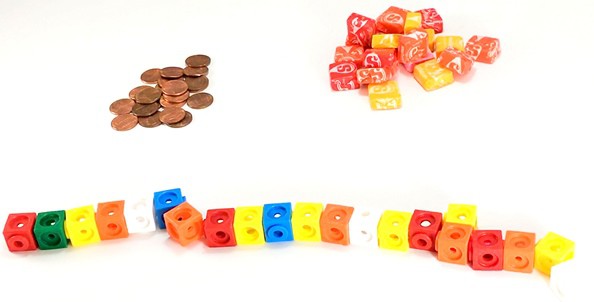 Image Credit: Sabine De Brabandere, Science Buddies / Science Buddies
Image Credit: Sabine De Brabandere, Science Buddies / Science Buddies
Instructions
- On the paper with the triangle use the 21 pennies (small blocks or stackable objects) to build towers on each circle. Each circle must have at least 1 penny, but no two circles can have the same number of pennies (or no two towers can be of the same height).Can you do it?
- Keep trying until you find a solution!
- Count the number of pennies (or objects) in each tower. Write these numbers down in order from the smallest to the largest number.What do you notice about this set of numbers?
- Shift the towers around or rebuild them until you can fulfill one more requirement: The total number of pennies used to build the three towers on each side of the triangle must be the same. For example:
- If you build towers of 1, 5 and 3 pennies in the circles lining up on one side of the triangle, you used 1 + 5 + 3 = 9 pennies on that side.
- Lining up towers of 1, 2 and 4 pennies on the adjacent side would not work because 1+ 2 + 4 = 7 —not 9 like the first side. (Notice the tower of 1 penny was placed on the corner of this triangle, so it contributes to two sides.)
If you tried 1, 2 and 6 for the adjacent side instead, that works because 1 + 2 + 6 = 9.
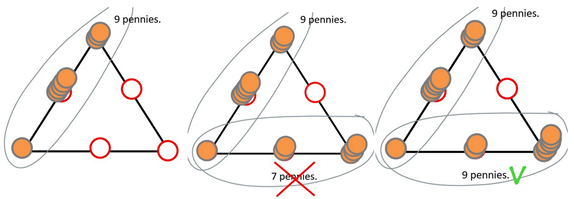 Image Credit: Sabine De Brabandere, Science Buddies / Science Buddies
Image Credit: Sabine De Brabandere, Science Buddies / Science Buddies
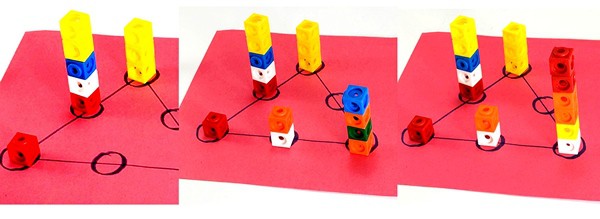 Image Credit: Sabine De Brabandere, Science Buddies / Science Buddies
Image Credit: Sabine De Brabandere, Science Buddies / Science Buddies
- Now you can place the one tower that is left and check if 9 pennies are used in the three towers on the third side of this triangle. Try it out!
Did you find a solution?
- If this is not a solution, think.
Can you rearrange a few towers and get a solution?
- Using 9 pennies per side is possible!Did you find the solution? Are there several ways you can arrange the towers so there are 9 pennies used per side?
- If working with abstract numbers is easier for you, replace the towers with the number disks. Each number disks then represents a tower of pennies. The number written on the number disks informs you of the number of pennies in that tower.
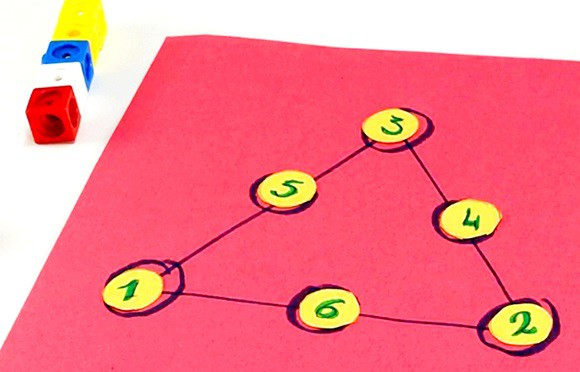 Image Credit: Sabine De Brabandere, Science Buddies / Science Buddies
Image Credit: Sabine De Brabandere, Science Buddies / Science Buddies
- Try to arrange the pennies so you use 10, 11 or even 12 pennies per side.Do you have a strategy to find solutions? Can you explain the way you find solutions to a neighbor or friend?
What Happened?
Did you find that you can only arrange the 21 pennies in towers of 1, 2, 3, 4, 5, and 6 pennies if you need to make six towers of different heights? Could you come up with ways to arrange the towers so the sum of pennies used on each side of the triangle is identical for all three sides? It is possible for a total of 9, 10, 11, and 12 pennies per side.
To use a total of 9 pennies on each side, you place the towers with 1, 2, and 3 pennies on the corners of the triangle. The tower of 6 pennies goes in between the towers of 1 and 2 pennies because 1 + 2 + 6 = 9. The tower of 5 pennies stands between the tower of 1 and the tower of 3 pennies, as 1 + 3 + 5 also equals 9. The towers with 2, 4, and 3 pennies fill up the third row. Notice how the smallest towers are placed on the corners for this solution.
To arrange the towers so that you use 12 pennies on each side start by arranging the tallest towers (those with 6, 5, and 4 pennies) on the corners of your triangle and fill in the circles in between. Place the smallest tower you have left (1 penny tall) in between the two tallest towers (5 and 6 pennies each). Do you see that the smallest one you are left with (2 pennies tall) goes in between the tallest ones that need a tower in between (the towers with 6 and 4 pennies each)?
A strategy you could use to find the solution that has 10 pennies on each side is listing all the ways you can make 10 by adding three different numbers. You will find 3 + 2 + 5 = 10, 5 + 4 + 1 = 10, and 1 + 6 + 3 = 10. Can you see that 3, 5, and 1 are part of two of these sums? This means these go on the corners of your triangle. You can use the same strategy to find out how to place the pennies so there are 9, 11, or 12 pennies used on each side.
Are you wondering how you can know that using 8 pennies per side is not possible? With 8 pennies per side you use 3 × 8, or 24, pennies for the triangle. Because you reuse the pennies on the corner towers you at least use 1 + 2 + 3 (the sum of the three smallest towers) or 6 pennies fewer. In other words, you can use at most 18 pennies. The puzzle asks you to use 21.
Digging Deeper
Counting is so common that we forget how it is connected to the broader area of mathematics that studies numbers, known as arithmetic. We can see counting as repeatedly adding one: when you add one object to another you have two objects. Add one more and you have three, and so on. Addition is the process of adding numbers. The result of the addition is called the sum. With smaller numbers you might use counting to find the sum. When you have three and want to add two, for example, you can count two numbers beyond three to get to five. With plenty of practice you can often memorize the sums of the numbers one through 10—at which point in can be fun to play with numbers to find all the ways you can make a particular sum.
Math puzzles and games can be a fun way to get practice working with numbers. Puzzles also provide entertaining ways to build strategic and logical thinking. With a little trial and error you can often start to find new strategies to complete a puzzle faster. These are the very same techniques mathematicians use: starting small and trying to find patterns in the sequence of answers. These patterns are then used to predict the answers to even bigger puzzles.
Ask an Expert
For Further Exploration
- Show that there are no solutions that use 8 or fewer pennies per side—or show that there are no solutions with a total of 13 or more pennies per side.
- The puzzle presented in this activity is called a "perimeter magic triangle of order three." To extend it to a higher-order perimeter magic triangle start by drawing a new triangle. Add circles on the corners like you did the first time, but this time add two more circles on each side in between the corners as shown in the figure. For this puzzle you will need nine number disks. Number them 1 through 9. Just like in the previous puzzle you need to find ways to place the disks on the circles so the sums of the numbers on each side of this triangle are identical. Mathematicians call this triangle a triangle of order four as it has four numbers on each side.
Once you have solved this puzzle continue with a triangle of order five (add three more circles between the corners and cut 12 number disks), then order six, and so on.
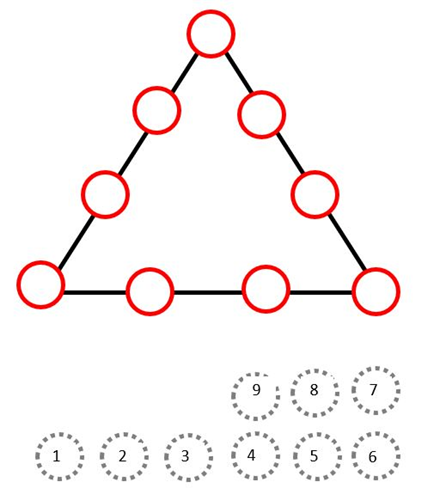 Image Credit: Sabine De Brabandere, Science Buddies / Science Buddies
Image Credit: Sabine De Brabandere, Science Buddies / Science Buddies
- Create a strategy to find solutions for this type of puzzle quickly, or predict how many solutions a perimeter magic triangle or specific order will have, and then solve that puzzle and see if your prediction matches the number of solutions you found. To check your solutions, you can look them up online.


